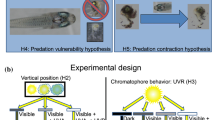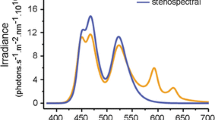Abstract
Most research on environmental effects of ultraviolet radiation (UVR) has focused on its potential negative consequences. However, natural UVR can also be beneficial to living organisms (e.g., vitamin D synthesis, UV vision, germicide activity). UV vision has been demonstrated in a variety of animals including several invertebrates and vertebrates. Juvenile rainbow trout, Oncorhynchus mykiss, has a retinal photoreceptor, which is sensitive to UVR between 360 and 370 nm. Among other functions, UV vision has been proposed to contribute to prey detection by enhancing the contrast between the prey and its background. We performed a series of feeding experiments with juvenile rainbow trout and several zooplankters as prey. The fish were allowed to feed either under full solar radiation, or under solar radiation from which the UV component had been removed using a long-pass cut off filter. We found that the removal of UV wavelengths had no effect on the number of prey eaten or on the preference for particular food items. This is contrary to published studies reporting prey detection enhancement mediated by UV vision in rainbow trout. This disparity in the results may be due to our use of natural radiation instead of artificial UV sources, in which the visible component is poorly represented. Although our results do not disproof the presence of UV vision in juvenile rainbow trout, they do cast doubts about its significance in enhancing feeding performance in a natural light environment.
Similar content being viewed by others
References cited
Angradi, T.R.&S.J. Griffith. 1990. Diel feeding chronology and diet selection of rainbow trout (Oncorhynchus mykiss) in the Henrry's Fork of the Snake River, Idaho. Can. J. Fish. Aquat. Sci. 47: 199–209.
Boisclair, D. 1992. Relationship between feeding and activity rates for actively foraging juvenile brook trout (Salvelinus fontinalis). Can. J. Fish. Aquat. Sci. 49: 2566–2573.
Bowmaker, J.K.&Y.L. Kunz. 1987. Ultraviolet receptors, tetrachromatic colour vision and retinal mosaics in brown trout (Salmo trutta): age dependent changes. Vision Research 27: 2101–2108.
Browman, H.I.&C.W. Hawryshyn. 1992. Thyroxine induces a precocial loss of ultraviolet photosensitivity in rainbow trout (Oncorhynchus mykis, Teleostei). Vision Research 32: 2303–2312.
Browman, H.I., I. Novales-Flamerique& C.W. Hawryshyn. 1994. Ultraviolet photoreception contributes to prey search behaviour in two species of zooplanktivorous fishes. J. Exp. Biol. 186: 187–198.
Carpenter, K.J.&L. Zhao. 1999. Forgotten mysteries in the early history of vitamin D. J. Nutri. 129: 923–927.
Downing, J.E.G., M.B.A. Djamgoz& J.K. Bowmaker. 1986. Photoreceptors of a cyprinid fish, the roach: morphological and spectral characteristics. J. Com. Physiol. A 159: 859–868.
Elliott, J.M. 1975a. The growth of brown trout (Salmo truta L.) fed on reduced rations. J. Anim. Ecol. 44: 823–842.
Elliott, J.M. 1975b. The growth rate of brown trout, Salmo trutta L., fed on maximum rations. J. Anim. Ecol. 44: 805–821.
Elliott, J.M. 1975c. Number of meals in a day, maximum weight of food consumed in a day and maximum rate of feeding for brown trout, Salmo trutta L. Freshwater Biol. 5: 287–303.
Farman, J.C., B.G. Gardiner& J.D. Shanklin. 1985. Large losses of total ozone in the Antarctica reveal seasonal ClOx/NOx interaction. Nature 315: 207–210.
Häder, D.-P., R.C. Worrest, H.D. Kumar& R.C. Smith. 1995. Effects of increased solar ultraviolet radiation on aquatic ecosystems. Ambio 24: 174–180.
Hawryshyn, C.W. 1992. Polarization vision in fish. Amer. Sci. 80: 164–175.
Jacobs, G.H. 1992. Ultraviolet vision in vertebrates. Amer. Zool. 32: 544–554.
Loew, E.R., W.N. McFarland, E.L. Mills& D. Hunter. 1993. A chromatic action spectrum for planktonic predation by juvenile yellow perch, Perca flavescens. Can. J. Zool. 71: 384–386.
Losey, G.S., T.W. Cronin, T.H. Goldsmith, D. Hyde, N.J. Marshall& W.N. McFarland. 1999. The UV visual world of fishes: a review. J. Fish Biol. 54: 921–943.
Madronich, S. 1994. Increases in biologically damaging UV-B radiation due to stratospheric ozone reductions: a brief review. Arch. Hydrobiol. Beih. Ergebn. Limnol. 43: 17–30.
Martin, G.G., C. Speekmann& S. Beidler. 2000. Photobehavior of the harpacticoid copepod Tigriopus californicus and the fine structure of its nauplius eye. Invert. Biol. 119: 110–124.
Riehle, M.D.&J.S. Griffith. 1993. Changes in habitat use and feeding chronology of juvenile rainbow trout (Oncorhynchus mykiss) in fall and the onset of winter in Silver Creek, Idaho. Can. J. Fish. Aquat. Sci. 50: 2119–2128.
Smith, K.C.&E.R. Macagno. 1990. UV photoreceptors in the compound eye of Daphnia magna (Crustacea: Branchiopoda). A fourth spectral class in single omatidia. J. Com. Physiol. A 166: 597–606.
von Frisch, K. 1967. The dance language and orientation of bees. Belknap Press, Cambridge. 580 pp.
Wehner, R. 1992. Homing in artropods. pp. 45–144. In: D.R. Papaj (ed.) Animal Homing, Chapman & Hall, London.
Worrest, R.C. 1986. The effect of solar UV-B radiation on aquatic systems: an overview. pp. 175–191. In: J.G. Titus (ed.) Effects of Changes in Stratospheric Ozone and Global Climate, U.S.E.P.A., Washington D.C.
Author information
Authors and Affiliations
Rights and permissions
About this article
Cite this article
Rocco, V., Pablo Barriga, J., Zagarese, H. et al. How Much Does Ultraviolet Radiation Contribute to the Feeding Performance of Rainbow Trout, Oncorhynchus mykiss, Juveniles under Natural Illumination?. Environmental Biology of Fishes 63, 223–228 (2002). https://doi.org/10.1023/A:1014240018206
Issue Date:
DOI: https://doi.org/10.1023/A:1014240018206




